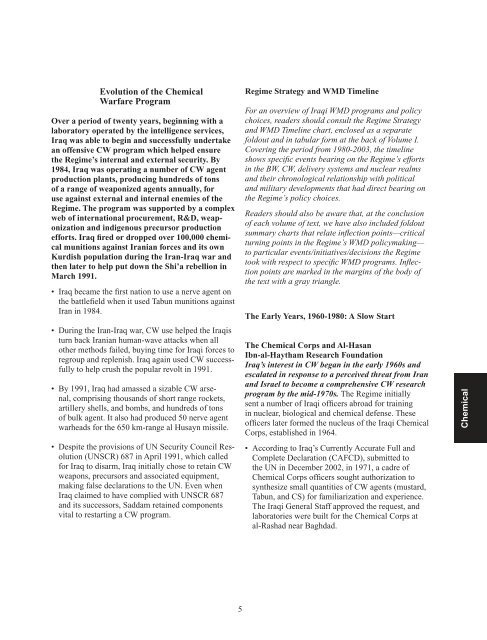Comprehensive Report
GPO-DUELFERREPORT-3
GPO-DUELFERREPORT-3
- No tags were found...
You also want an ePaper? Increase the reach of your titles
YUMPU automatically turns print PDFs into web optimized ePapers that Google loves.
Evolution of the Chemical<br />
Warfare Program<br />
Over a period of twenty years, beginning with a<br />
laboratory operated by the intelligence services,<br />
Iraq was able to begin and successfully undertake<br />
an offensive CW program which helped ensure<br />
the Regime’s internal and external security. By<br />
1984, Iraq was operating a number of CW agent<br />
production plants, producing hundreds of tons<br />
of a range of weaponized agents annually, for<br />
use against external and internal enemies of the<br />
Regime. The program was supported by a complex<br />
web of international procurement, R&D, weaponization<br />
and indigenous precursor production<br />
efforts. Iraq fired or dropped over 100,000 chemical<br />
munitions against Iranian forces and its own<br />
Kurdish population during the Iran-Iraq war and<br />
then later to help put down the Shi’a rebellion in<br />
March 1991.<br />
• Iraq became the first nation to use a nerve agent on<br />
the battlefield when it used Tabun munitions against<br />
Iran in 1984.<br />
• During the Iran-Iraq war, CW use helped the Iraqis<br />
turn back Iranian human-wave attacks when all<br />
other methods failed, buying time for Iraqi forces to<br />
regroup and replenish. Iraq again used CW successfully<br />
to help crush the popular revolt in 1991.<br />
• By 1991, Iraq had amassed a sizable CW arsenal,<br />
comprising thousands of short range rockets,<br />
artillery shells, and bombs, and hundreds of tons<br />
of bulk agent. It also had produced 50 nerve agent<br />
warheads for the 650 km-range al Husayn missile.<br />
• Despite the provisions of UN Security Council Resolution<br />
(UNSCR) 687 in April 1991, which called<br />
for Iraq to disarm, Iraq initially chose to retain CW<br />
weapons, precursors and associated equipment,<br />
making false declarations to the UN. Even when<br />
Iraq claimed to have complied with UNSCR 687<br />
and its successors, Saddam retained components<br />
vital to restarting a CW program.<br />
Regime Strategy and WMD Timeline<br />
For an overview of Iraqi WMD programs and policy<br />
choices, readers should consult the Regime Strategy<br />
and WMD Timeline chart, enclosed as a separate<br />
foldout and in tabular form at the back of Volume I.<br />
Covering the period from 1980-2003, the timeline<br />
shows specifi c events bearing on the Regime’s efforts<br />
in the BW, CW, delivery systems and nuclear realms<br />
and their chronological relationship with political<br />
and military developments that had direct bearing on<br />
the Regime’s policy choices.<br />
Readers should also be aware that, at the conclusion<br />
of each volume of text, we have also included foldout<br />
summary charts that relate infl ection points—critical<br />
turning points in the Regime’s WMD policymaking—<br />
to particular events/initiatives/decisions the Regime<br />
took with respect to specific WMD programs. Inflection<br />
points are marked in the margins of the body of<br />
the text with a gray triangle.<br />
The Early Years, 1960-1980: A Slow Start<br />
The Chemical Corps and Al-Hasan<br />
Ibn-al-Haytham Research Foundation<br />
Iraq’s interest in CW began in the early 1960s and<br />
escalated in response to a perceived threat from Iran<br />
and Israel to become a comprehensive CW research<br />
program by the mid-1970s. The Regime initially<br />
sent a number of Iraqi officers abroad for training<br />
in nuclear, biological and chemical defense. These<br />
officers later formed the nucleus of the Iraqi Chemical<br />
Corps, established in 1964.<br />
• According to Iraq’s Currently Accurate Full and<br />
Complete Declaration (CAFCD), submitted to<br />
the UN in December 2002, in 1971, a cadre of<br />
Chemical Corps officers sought authorization to<br />
synthesize small quantities of CW agents (mustard,<br />
Tabun, and CS) for familiarization and experience.<br />
The Iraqi General Staff approved the request, and<br />
laboratories were built for the Chemical Corps at<br />
al-Rashad near Baghdad.<br />
Chemical<br />
5


